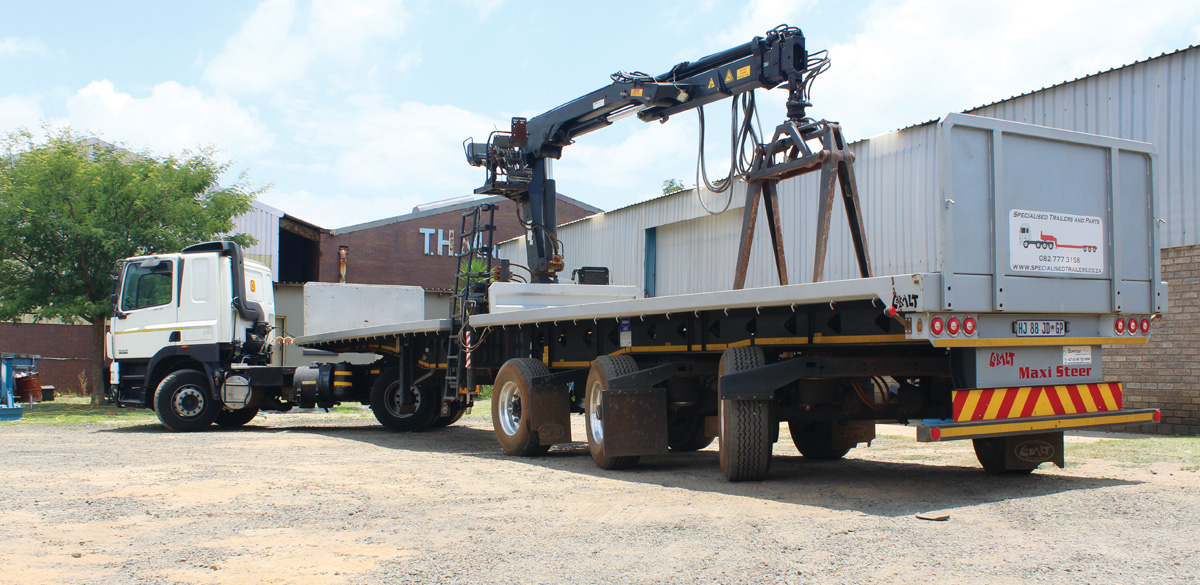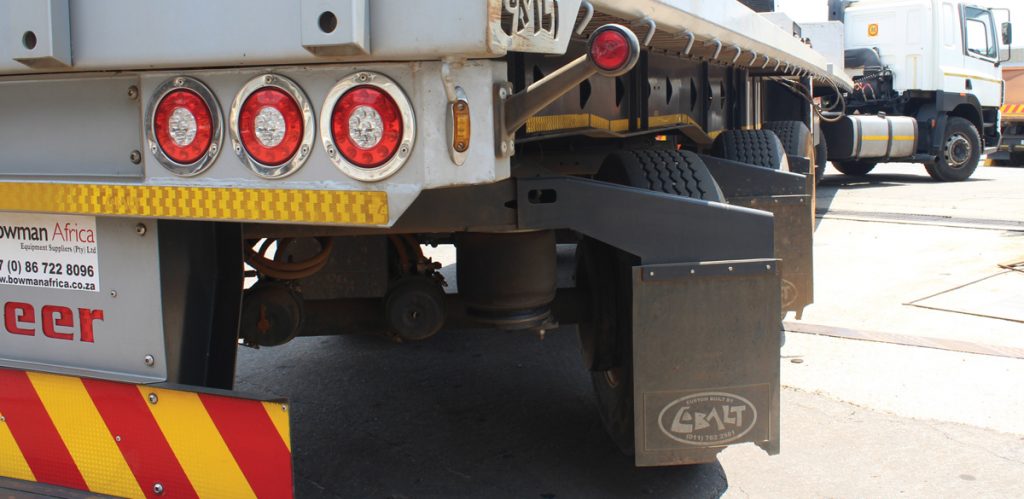Why you might want to steer from the rear

In the search for ultimate trucking efficiency, it would make sense that both the horse and the trailer, as a unit, should run as efficiently as possible. This includes reducing as much rolling resistance as possible. GAVIN MYERS finds out how steered trailers are helping to achieve this.
Steered trailers are nothing new. They’ve been used to transport abnormal loads for eons and their benefits are numerous – easier manoeuvrability being chief among them. So, what would happen if the concept was applied to a general high-volume application?
This is something many such transporters in Europe have been playing with for a while, primarily as a means to aid manoeuvrability in the narrow streets of many old European towns. However, there were some unexpected additional benefits that have had a direct effect on the bottom line, too.
Christo de Clerk, product manager: Tridec Steering at Jost South Africa (Tridec is a Dutch brand, owned by Jost), explains that trailer maintenance costs were found to have decreased dramatically and that the driver had an easier time behind the wheel.
“Truck manufacturers are boosting efficiency and lowering running costs at an astonishing rate, but not much has changed in the last 20 years on trailers aside from lowering weight and production costs,” he points out.
“Trailers have been stuck; they are friction-generating steel planks on wheels that cannot keep up with the latest generation of trucks sold in South Africa. What is the use of selling a truck with 50 000-km service intervals when the trailer needs to be unhitched every two or three weeks to clean and lubricate the fifth wheel?

“The solution is to get rid of all the friction, because friction causes wear that requires regular maintenance, increasing downtime and running costs.”
De Clerk has taken it upon himself to prove the benefits of steered trailers in the South African market. Just over a year ago he began designing and building a 15-m steered tri-axle trailer with Krugersdorp-based Cobalt Trailers, which specialises in building steered, low-bed, abnormal-load trailers.
“Cobalt was enthusiastic to get involved and give the concept some love,” he says.
The prototype design has resulted in a trailer that runs the Tridec TR Two-Axle Mechanical-Steer System. It has been dubbed the Maxisteer.
“Each Maxisteer trailer is designed individually, taking into account the operator’s requirements and application. All three axles can be steered, but with this trial unit we wanted to retain some familiarity: by steering only the rear two axles there is a smaller learning curve for the driver. Steering the front axle as well will realise even more manoeuvrability.”
With axles spaced 2,1-m apart (as opposed to the traditional 1,3 m) the prototype trailer requires 1,5-m less road space to make the same turn as a traditional tri-axle. “With all three axles steered there is the potential for the trailer to overshoot the standard 13,1-m outside turning radius, and this could catch out unfamiliar drivers,” De Clerk explains.
The extra space between the axles also gives the trailer a larger footprint. This means the suspension has more time to react to the road surface, reducing the impact on suspension components and increasing the trailer’s stability.

For the past year, the prototype Maxisteer has completed a 30 000-km trial with brick haulier Omnitrans. The results have been encouraging to say the least. For starters, the trailer allows the brick haulier to carry 12 000 bricks (double that of a standard 8×4 rigid truck) and it is also allowed into estates, as it does not damage the road surface – something they cannot do with a standard tri-axle.
Pieter Naudé, depot manager at Omnitrans, comments: “Delivery times are faster. The truck easily manages corners and roundabouts and, because we’re using half the number of vehicles for the same job, we’re saving our suppliers and customers time and money, while reducing traffic.”
Naudé adds that the Omnitrans drivers also notice the difference. “The drivers love it. Once they become accustomed to the fact that it can turn in a single lane, they don’t want to change. It’s much less taxing for them. They don’t need to wait for traffic to clear in order to make a turn and, as they need to put in less effort, they can relax a little.”
While comparing the running costs to a traditional tri-axle trailer would need more time in operation, chatting to De Clerk and Naudé reveals that the savings seem to be adding up.
“We fitted a set of our own tyres and these have now completed over 40 000 km with minimal evidence of wear,” says Naudé. “The only maintenance we have undertaken has been to grease the turntables every six months, because our vehicles regularly run on dirt roads,” he adds.
De Clerk is not surprised by this. “The steering system eliminates all the stress of side loads and friction from the trailer as it experiences vertical loads only (moving forwards and backwards). The highest point of friction is between the tyre and the road, but, because the tyres are steered and tyre scrub is eliminated, we expect double the tyre life – and lower fuel consumption, too.

“In normal operation we suggest greasing the turntables every 50 000 km or so, and the trailer doesn’t even have to be unhitched to do so. In theory it never has to be unhitched… Because the trailer is fixed to the fifth wheel, a little bit of Q20 on the fifth wheel to keep the rust away is all that’s needed,” he adds, suggesting that, at the earliest, turntables and steering rods may need to be replaced every six to eight years. (See “How does the Maxisteer steer?” on pg 21.)
To allay fears, Jost offers a one-year/100 000 km factory warranty on all steering components. As every system is unique to the trailer for which it is designed, the trailer is issued with a serial number so that it’s easier to track and supply spares.
“A normal trailer is cheap to buy, but maintenance increases after three years of operation. We now have the first trailer that can at least match the 50 000-km maintenance intervals of a modern truck tractor. We can’t accurately quantify the savings over a short period because there simply isn’t the same component wear as on normal trailers. However, even at a premium of around R200 000 over a standard tri-axle, we expect this will be recouped in just two years of operation due to the increased efficiencies,” De Clerk says.
Nonetheless, Omnitrans has placed an order for two units and this demo unit is headed for time with a number of operators, including SAB, ABI, Brass Trucking and Botha Transport.
“It’s a radical step for operators, so the proof will be in the pudding,” De Clerk concludes enthusiastically.
How does the Maxisteer steer?
The truck tractor retains its standard fifth wheel. On the trailer a standard kingpin is mounted to a turntable with a steering wedge. This assembly locks into the fifth wheel, which means that when the truck turns it also rotates the turntable and steering wedge.
An offset point then transfers this movement to two steering rods that run to the rearmost axle turntable (each complete axle is mounted on a turntable). This rearmost axle is connected to the axle ahead of it, allowing for both to turn.
The result is a tyre angle that is always 90° to the turn. On this particular trailer the maximum steering angles (when the trailer is at 90° to the truck) are 21° at the mid axle and 45° at the rear axle. Every system is, however, unique to its design.
York Zonneveld, owner of Cobalt Trailers, suggests that building the Maxisteer trailer is not much different to building a traditional tri-axle. “The prototype weighs in at 7,2 t, but we built it heavy. We could easily save another 400 kg, potentially 600 kg, which would be amazing,” he comments.
Published by
Focus on Transport
focusmagsa




